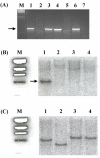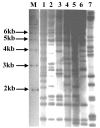Variation suggestive of horizontal gene transfer at a lipopolysaccharide (lps) biosynthetic locus in Xanthomonas oryzae pv. oryzae, the bacterial leaf blight pathogen of rice
- PMID: 15473911
- PMCID: PMC524487
- DOI: 10.1186/1471-2180-4-40
Variation suggestive of horizontal gene transfer at a lipopolysaccharide (lps) biosynthetic locus in Xanthomonas oryzae pv. oryzae, the bacterial leaf blight pathogen of rice
Abstract
Background: In animal pathogenic bacteria, horizontal gene transfer events (HGT) have been frequently observed in genomic regions that encode functions involved in biosynthesis of the outer membrane located lipopolysaccharide (LPS). As a result, different strains of the same pathogen can have substantially different lps biosynthetic gene clusters. Since LPS is highly antigenic, the variation at lps loci is attributed to be of advantage in evading the host immune system. Although LPS has been suggested as a potentiator of plant defense responses, interstrain variation at lps biosynthetic gene clusters has not been reported for any plant pathogenic bacterium.
Results: We report here the complete sequence of a 12.2 kb virulence locus of Xanthomonas oryzae pv. oryzae (Xoo) encoding six genes whose products are homologous to functions involved in LPS biosynthesis and transport. All six open reading frames (ORFs) have atypical G+C content and altered codon usage, which are the hallmarks of genomic islands that are acquired by horizontal gene transfer. The lps locus is flanked by highly conserved genes, metB and etfA, respectively encoding cystathionine gamma lyase and electron transport flavoprotein. Interestingly, two different sets of lps genes are present at this locus in the plant pathogens, Xanthomonas campestris pv. campestris (Xcc) and Xanthomonas axonopodis pv. citri (Xac). The genomic island is present in a number of Xoo strains from India and other Asian countries but is not present in two strains, one from India (BXO8) and another from Nepal (Nepal624) as well as the closely related rice pathogen, Xanthomonas oryzae pv. oryzicola (Xoor). TAIL-PCR analysis indicates that sequences related to Xac are present at the lps locus in both BXO8 and Nepal624. The Xoor strain has a hybrid lps gene cluster, with sequences at the metB and etfA ends, being most closely related to sequences from Xac and the tomato pathogen, Pseudomonas syringae pv. tomato respectively.
Conclusion: This is the first report of hypervariation at an lps locus between different strains of a plant pathogenic bacterium. Our results indicate that multiple HGT events have occurred at this locus in the xanthomonad group of plant pathogens.
Figures







Similar articles
-
The role of horizontal transfer in the evolution of a highly variable lipopolysaccharide biosynthesis locus in xanthomonads that infect rice, citrus and crucifers.BMC Evol Biol. 2007 Dec 6;7:243. doi: 10.1186/1471-2148-7-243. BMC Evol Biol. 2007. PMID: 18053269 Free PMC article.
-
The genome sequence of Xanthomonas oryzae pathovar oryzae KACC10331, the bacterial blight pathogen of rice.Nucleic Acids Res. 2005 Jan 26;33(2):577-86. doi: 10.1093/nar/gki206. Print 2005. Nucleic Acids Res. 2005. PMID: 15673718 Free PMC article.
-
Genetic diversity of transcriptional activator-like effector genes in Chinese isolates of Xanthomonas oryzae pv. oryzicola.Phytopathology. 2014 Jul;104(7):672-82. doi: 10.1094/PHYTO-08-13-0232-R. Phytopathology. 2014. PMID: 24423401
-
Resistance Genes and their Interactions with Bacterial Blight/Leaf Streak Pathogens (Xanthomonas oryzae) in Rice (Oryza sativa L.)-an Updated Review.Rice (N Y). 2020 Jan 8;13(1):3. doi: 10.1186/s12284-019-0358-y. Rice (N Y). 2020. PMID: 31915945 Free PMC article. Review.
-
A review of approaches to control bacterial leaf blight in rice.World J Microbiol Biotechnol. 2022 May 17;38(7):113. doi: 10.1007/s11274-022-03298-1. World J Microbiol Biotechnol. 2022. PMID: 35578069 Review.
Cited by
-
Modifications of Xanthomonas axonopodis pv. citri lipopolysaccharide affect the basal response and the virulence process during citrus canker.PLoS One. 2012;7(7):e40051. doi: 10.1371/journal.pone.0040051. Epub 2012 Jul 6. PLoS One. 2012. PMID: 22792211 Free PMC article.
-
Mechanistic insights into host adaptation, virulence and epidemiology of the phytopathogen Xanthomonas.FEMS Microbiol Rev. 2020 Jan 1;44(1):1-32. doi: 10.1093/femsre/fuz024. FEMS Microbiol Rev. 2020. PMID: 31578554 Free PMC article. Review.
-
Horizontal gene transfer: sustaining pathogenicity and optimizing host-pathogen interactions.Mol Plant Pathol. 2009 Jan;10(1):143-50. doi: 10.1111/j.1364-3703.2008.00518.x. Mol Plant Pathol. 2009. PMID: 19161360 Free PMC article. Review.
-
INDeGenIUS, a new method for high-throughput identification of specialized functional islands in completely sequenced organisms.J Biosci. 2010 Sep;35(3):351-64. doi: 10.1007/s12038-010-0040-4. J Biosci. 2010. PMID: 20826944
-
Genomic diversity and organization of complex polysaccharide biosynthesis clusters in the genus Dickeya.PLoS One. 2021 Feb 11;16(2):e0245727. doi: 10.1371/journal.pone.0245727. eCollection 2021. PLoS One. 2021. PMID: 33571209 Free PMC article.
References
Publication types
MeSH terms
Substances
Associated data
- Actions
- Actions
- Actions
- Actions
- Actions
- Actions
- Actions
LinkOut - more resources
Full Text Sources
Other Literature Sources
Research Materials
Miscellaneous

